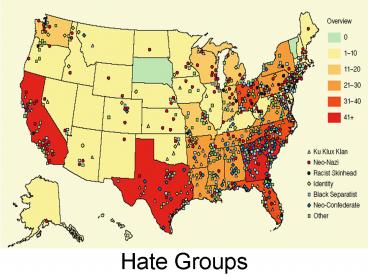Hate Groups - PowerPoint PPT Presentation
1 / 19
Title: Hate Groups
1
Hate Groups
2
Definitions
- Prejudice Negative attitude
toward category of people,
such as
racial or ethnic minority. - Prejudice- an attitude
- Discrimination- an action (behavior)
Two main categories of discrimination 1.
Individual discrimination - one-on-one acts by
members of dominant group that harm members of
subordinate group or their property 2.
Institutional discrimination - day-to-day
practices of organizations and institutions that
have harmful impact on members of subordinate
groups
3
Robert Mertons Typology of Prejudice and
Discrimination
- Four patterns
- 1. Unprejudiced nondiscriminatory integration
- 2. Unprejudiced and discriminatory
institutional discrimination - 3. Prejudiced and nondiscriminatory latent
bigotry - 4. Prejudiced and discriminatory outright
bigotry
4
(No Transcript)
5
- Ethnocentrism Tendency to assume
that ones culture and way of life are superior - Ethnophaulism Ethnic or
racial slurs - including derisive nicknames. - Scapegoating Group
collectively identifies another group as threat
blames for problems
6
Forms of Racism
- Active racism act intending to exclude or make
person feel inferior because of his/her minority
group - Passive racism act of being complicit in
anothers racism - Cultural racism values that reinforce interests
of dominant group while undermining interests of
subordinate group, e.g., hostility to employment
equity
7
Why Conflict Between Groups?
- Ingroup-outgroup bias
- Favoring ingroup over outgroup
- we are better than them
- ethnocentrism
- Ingroup favoritism tends to be stronger
than outgroup rejection - Nationalism is produced by 'us' and 'them'
orientation. - -Tends to be destructive to multiculturalism
- Two types of nationalism
- Civic nationalism - community of citizens who
express loyalty and patriotic attachment to
shared set of values - Ethnic nationalism - involves tracing roots,
search for identity, political recognition of
heritage
8
Type of Social Movements
- Alternative Least threatening, limited
change-Planned parenthood - Personal transformation - Hippies, New Agers,
Meditation, Yoga, Communes - Social change environmental
and animal rights movements-
PETA, GreenPeace - Reactionary - Aryan Nation, Right-to-Life,
Apocalypse Soon
9
Figure 23.1 Four Types of Social MovementsThere
are four types of social movements, reflecting
who is changed and how great the change
is.Source Based on Aberle (1966)
10
- Hate Crimes Criminal offense committed with
provable bias (hate) of perpetrator toward victim
due to race, religion, ethnic background,
national origin or sexual orientation. - Hate Crime Statistics Act of 1990
- 7,489 reported incidents of hate crimes 2003
- 52.5 - motivated by racial bias, 16.4 by
religious bias, 16.4 by sexual orientation, and
14.2 by ethnicity or national origin. - Crimes of violence represented 63.3 of hate
crimes. Murder accounted for only .1 of
reported hate crimes. - Majority committed by teens, primarily white
males
11
Genocide
Whitlock's Line of Acceptance
Expulsion
Segregation
Cultural Pluralism
Integration
Assimilation
Amalgamation
12
(No Transcript)
13
Sociological Perspectives
Sociological Perspective Level of Analysis Focus
1. Symbolic Interactionism Micro Use of symbols Face-to-face interactions
2. Functionalism Macro Relationship between the parts of society How aspects of society are functional (adaptive)
3. Conflict Theory Macro Competition for scarce resources How the elite control the poor and weak
14
Symbolic Interactionist Perspective
- Looks at social construction of ethnic
differences and subordination of minority groups,
through racial labels - Symbols are language, clothing, cars, etc.
15
- Functionalist Perspective
- believes that inequality benefits society by
allowing for discussion of opinions,
perspectives, and values - maintains that inequality produces social
conflict that intensifies people's sense of
identity and belonging, gives groups more
cohesion along with better sense of purpose
16
- Conflict perspective
- Focus on how one group more than another benefits
from differentiation, exclusion, and
institutional racism. - Groups are in conflict
17
What Interpersonal Factors Disrupt Relations
Between Groups?
- The Robbers Cave Experiment
- Conducted by Muzafer and Carolyn Sherif and
colleagues in 1950s - Two groups of 11 yr boys 11-The
Rattlers and 11-The Eagles
18
The Robbers Cave Experiment
- Result Reactions to conflict escalated from
exclusion to verbal abuse to discrimination to
violence - What caused the conflict between these two
groups?
Realistic conflict theory theory in social
psychology that ties into discrimination and
stereotypes. Limited resources will lead to
conflict within between groups and this is
direct reason why discrimination and stereotypes
develop within society. Muzafer Sherif.
19
Darkness cannot drive out darkness only light
can do that. Hate cannot drive out hate only
love can do that. Hate multiplies hate, violence
multiplies violence, and toughness multiplies
toughness in a descending spiral of
destruction....The chain reaction of evil--hate
begetting hate, wars producing more wars--must be
broken, or we shall be plunged into the dark
abyss of annihilation. Martin Luther King, Jr.





























![⚡[PDF]✔ 42 Reasons to Hate the Universe: (And One Reason Not To) PowerPoint PPT Presentation](https://s3.amazonaws.com/images.powershow.com/10056821.th0.jpg?_=20240616097)

